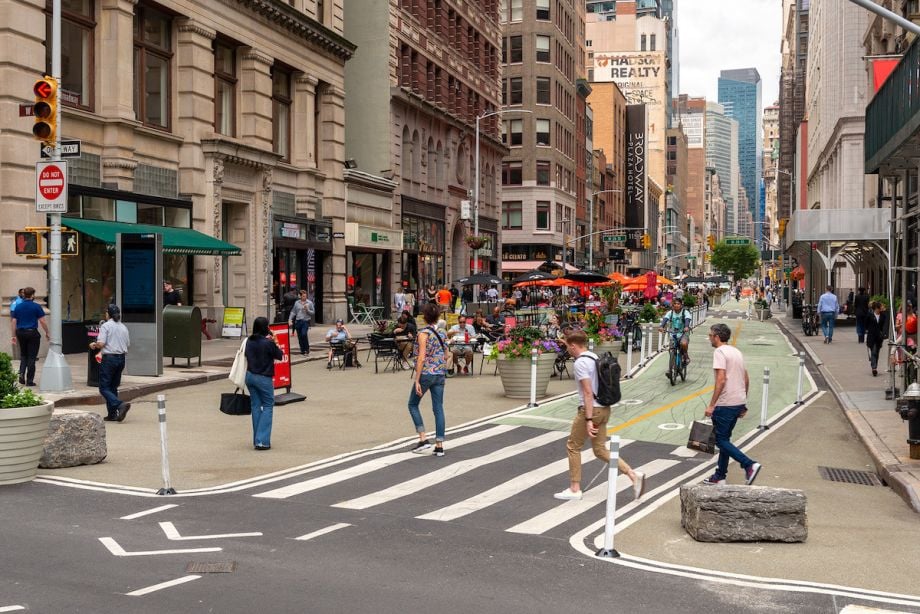The COVID-19 pandemic changed how people used public space in New York City, with streets like 34th Avenue in Queens shutting down to cars and opening up for neighbors to walk, bike and play.
Now, the New York City Department of Transportation is launching a new initiative, the Office of Livable Streets, to design and implement streets that accommodate people using all modes of transportation. It’s the first office of its kind in the U.S., according to the department.
The goal is to “create streets that are beyond the binary — it’s not just a place for cars or not cars,” Sean Quinn, associate deputy commissioner for the new office, tells Next City. “It’s a place for community, a place for activity, a place for cycling, a place for pedestrians, commerce, commercial development, all of that stuff.”
The new office rebrands what was previously known as the Office of Street Improvements. It consists of different sub-units, including the Public Realm, Bike, Policy and Innovation, Street Furniture, Street Improvement Projects Central and Administration units.
According to Quinn, the rebrand was born from the pandemic and the ways that New Yorkers started using streets as places to connect and build community — for example, through the Open Streets program — rather than as places to drive or park a car.
In New York City, the Department of Transportation has jurisdiction over everything on the surface of streets and sidewalks, including streetlights, street furniture (for example, bus benches and bike parking) and signage.
The office is redesigning streets to meet the needs of the people using it, building out typologies that use different levels of interventions. Quinn says that New Yorkers will be able to see block-by-block differences as they move down a street.
He explains it like this: Each corridor can have multiple typologies layered on top of each other to create different types of spaces. The interventions range from low-touch (for example, creating an open street using temporary barricades and signage) to high-touch (creating a pedestrian plaza that’s permanently closed to cars or adding a bike lane and safety improvements for pedestrians).
One example is Broadway Boulevard in Manhattan.
“Some of our designs are heavy-handed and very public-realm forward,” he says. “But even if you do just some minimal work on a quarter, just adding those barricades on the weekend, then you can add another layer of activation and activity.”
_920_613_80.jpeg)
A bike boulevard at Berry Street in Brooklyn. (Photo courtesy NYC DOT)
According to Quinn, it’s not about making trade-offs between different modes of transportation, but about changing a corridor to reflect the needs of the people who are already using it.
“Oftentimes, when you really dig down and look at the numbers, the pedestrians and cyclists do make up more of the volumes and the number of users on a corridor. And when you tell that story to the public, it’s eye-opening.”
That said, the office is focusing on micromobility from both a policy and a design standpoint to accommodate the surge in people riding bikes and scooters since the beginning of the pandemic.
“The number one barrier in New York City between New Yorkers and choosing to use a bike to get around is that they don’t feel safe doing so,” says Alexa Sledge, director of communications at Transportation Alternatives. She points out that 2023 was the second deadliest year for cyclists on record.
There are tradeoffs, Sledge believes, and the city should prioritize people who are using greener modes of transportation like biking.
“We aren’t building enough infrastructure to keep all those people safe,” she says.
The Office of Livable Streets is working to accommodate the cycling boom — both the increase in people choosing to bike commute, but also the increase in e-bikes and e-cargo bikes used for delivery. This includes new safety standards for e-cargo bikes, charging stations and bike storage for e-bike delivery workers and projects in 2024 to widen bike lanes.
“Every cargo bike that gets out there is one less truck trip,” says Quinn. “We’re not trying to limit commerce. But you know, we want to make sure we’re having a greener way of getting this stuff around the city.”
This story was produced through our Equitable Cities Fellowship for Social Impact Design, which is made possible with funding from the National Endowment for the Arts.

Maylin Tu is Next City's Equitable Cities Reporting Fellow for Social Impact Design. A freelance reporter based in Los Angeles, she writes about transportation and public infrastructure (especially bus shelters and bathrooms), with bylines in the Guardian, KCET, Next City, LAist, LA Public Press and JoySauce. She graduated with a BA in English from William Jewell College in Missouri.
Follow Maylin .(JavaScript must be enabled to view this email address)

















Add to the Discussion
Next City sustaining members can comment on our stories. Keep the discussion going! Join our community of engaged members by donating today.
Already a sustaining member? Login here.